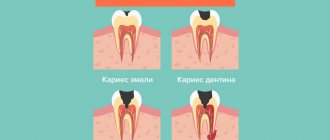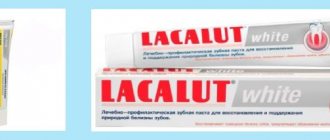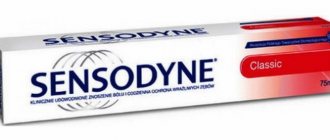4943
Kalasept is a modern Swedish-made drug that is actively used in endodontic dentistry for temporary filling of root canals.
The medicine is produced in the form of a finished paste, packed in an airtight container.
A few words about the manufacturer
Back in 1990, Scania Dental proved that calcium hydroxide used in dentistry must be sterile and hermetically packaged. Only this approach to storage eliminates contact of the substance with the external environment, in which it quickly hardens and loses its properties. Later, based on this information, the Swedish company Nordiska Dental developed Calasept. Today this paste is widely used in endodontics, periodontics and dental implantation.
Composition of Calasept
The composition of the drug Kalasept includes:
- barium sulfate 5%;
- calcium hydroxide 41%;
- sterile saline isotonic solution pH 12.4
The paste has a light viscosity and a uniform structure. The delivery set includes 5 syringe cartridges filled with the drug, as well as 30 pieces of disposable needles. The syringes are sealed and sterile. The plastic packaging is also airtight. This is due to the ability of the paste to quickly become hard when interacting with air. Calcium hydroxide, in contact with the external environment, is converted into calcium carbonate and then firmly fixed in the dental cavity. Calcium compounds fill cracks and restore dental tissue.
In addition to the drug itself, the Kalasept package contains instructions for use with a detailed indication of the composition
Composition and key characteristics of the drug
As mentioned above, the drug is based on calcium hydroxide - this substance activates regenerative functions and stops the spread of inflammation. "Kalasept" is used to disinfect canals and ensure their protection from the spread of pathogenic microflora. The composition contains the following components:
- calcium hydroxide,
- calcium chloride,
- sodium bicarbonate and sodium chloride.
The product is injected into the canals directly from the syringe. Therefore, one kit includes 5 hermetically sealed syringes filled with the substance, as well as 30 needles.
“I had my canals filled with this paste when I was treating pulpitis. Everything went fine. They put it in for about two weeks, I don’t remember exactly. There were no strange reactions from the tooth. Adverse reactions too. The doctor said that this is a good, proven remedy; after all, Sweden is a sign of quality.”
Antonina_V., from correspondence on the forum www.32top.ru
The drug is produced in hermetically sealed syringes.
Using this composition, canals are filled with pulpitis and used to protect the internal structures of the tooth from external aggressive factors. It is also indicated in the treatment of advanced caries, injuries and root fractures, to eliminate inflammatory processes in the pulp and provide its antibacterial treatment. As for how long you can leave “Kalasept” inside the tooth, the instructions on this matter indicate a period of up to six months.
Purpose and composition
The paste contains calcium hydroxide, which is actively used for the formation of new dental tissue, and also eliminates pathogenic microbes in the dental cavity.
The main purpose of the drug is temporary filling of canals.
Kalacept is used in modern dentistry for therapeutic and preventive purposes. It is used to process and treat canals.
The drug is used for the following procedures:
- Protects pulp and dentin from harmful bacteria and infections; the product is applied as a protective layer between the cavity and dental tissue.
- Treatment of caries of varying degrees of complexity.
- Treatment of fractures and root damage.
- Pulp restoration.
- Eliminates infection and provides long-term antibacterial protection.
One of the main areas of application of the drug is protecting the pulp when filling a tooth ; the paste is used to fill the root canal, and it is also used to create an insulating layer when working with deep cavities.
Kalacept is based on sterile calcium hydroxide; this chemical element promotes tissue restoration and reduces inflammatory processes.
Calcium hydroxide is an indispensable substance in the field of dentistry. In order for it to fully perform its functions, hydroxide should be protected from air when it is not in use.
Otherwise it will harden and become useless. Therefore, Kalasept is available in hermetically sealed syringes.
The product is placed through cannulas into the tooth cavity to sterilize the root canal. This procedure is necessary if there is a risk of penetration of pathogenic microorganisms and infections into the root dentin. The paste is well absorbed by structural tissues.
The drug contains:
- calcium hydroxide Ca (OH)2 – 56 g, white powdery substance, tasteless and odorless, neutralizing pathogenic nature;
- calcium chloride – 8 mg;
- sodium bicarbonate sodium – 4 mg;
- sodium chloride sodium – 350 mg.
The substance is injected into the root of the tooth using a syringe. Therefore, the kit contains five sealed syringes filled with paste and 30 needles.
In addition, to facilitate the administration of the drug, the kit includes disposable cannulas. All accessories are packed in sealed plastic containers.
Ionosit gasket material - its composition and properties.
Visit here to take a closer look at Proroot MTA dental material.
At this address https://www.vash-dentist.ru/lechenie/zubyi/plombyi/amalgame-v-stomatologii.html we will discuss how popular amalgam is in modern dentistry.
Properties of Kalasept paste
The drug is a liquid sterile substance with a pronounced hemostatic, antibacterial and anti-inflammatory effect. The product stops destructive processes and activates regeneration at the cellular level. By reacting with oxygen, the active substance quickly hardens and provides reliable protection of the internal structures of the tooth, while preventing further destruction of dentin.
Experts in the field of endodontics highlight the following main properties of Kalasept paste:
- antibacterial effect – protection against penetration of pathogenic microorganisms into dentin. A few minutes after application are enough to destroy all pathogenic microorganisms,
- stimulation of regenerative functions – the product promotes the appearance of secondary dentin and tubules,
- restoration - the composition fills and effectively eliminates cracks and damage.
The drug has an antibacterial and anti-inflammatory effect.
With this drug, specialists successfully treat even advanced forms of carious processes. The composition itself is moderately viscous, uniform in consistency, and does not cause irritation to periodontal tissue.
Properties
Kalasept is a liquid sterile material, which is an intracanal agent with the active biological properties of calcium hydroxide.
The drug has a hemostatic, anti-inflammatory effect , which prevents destructive processes and stimulates tissue regeneration.
The product is actively used by dentists during root canal filling . The substance hardens under the influence of air and creates reliable protection for the root system, while protecting dentin from destruction.
The paste has the following properties:
- antibiotic effect , due to which harmful microorganisms do not penetrate inside the tooth; within a couple of minutes after applying the paste, all microorganisms die;
- the regenerative function promotes the formation of dentinal canals and the formation of hard tissue in the upper regions of the root;
- The restoration function makes it possible to eliminate cracks and perforations that have arisen for one reason or another.
With the help of the product you can treat even very severe forms of caries. The paste is characterized by light viscosity, has a uniform consistency, and does not irritate periodonitis tissue.
Clinical indications and contraindications
The composition is completely absorbed by living tissues. It is used in the following clinical cases:
- cracks and fractures of the roots - the paste makes it possible to completely restore tissue if their integrity is violated, preserves the viability of the nerve and ensures the formation of replacement dentin. First, the doctor removes all damaged tissue of the root pulp, after which he carries out a special treatment of the canals and installs gutta-percha with preliminary filling with the drug “Kalasept”. If the pulp is too damaged, the doctor removes it completely, fills the canals with a product and installs a gutta-percha pin,
- deep caries and pulpitis - as part of therapy, the specialist makes applications directly into the affected cavities, which ensures the protection of dental tissues and the complete destruction of pathogenic microflora. 1-4 weeks after the procedure, complete sterility will be achieved due to the formation of secondary dentin,
- opened pulp - the paste is applied in layers to the affected area of the neurovascular bundle, thereby providing reliable protection against harmful microorganisms. The product also stimulates the process of regeneration of damaged tissues,
- affected canals - the paste is applied before permanent filling. The product ensures disinfection and calcification of dentinal tubules, and also seals the root apex,
- periodontitis – preparation for treatment,
- complications after tooth injuries (luxations and subluxations) - the product promotes the healing of damaged tissues.
The product is used for deep caries and pulpitis
. As mentioned above, the “Kalasept” product is actively used in the treatment of various forms of caries, pulpitis and periodontitis, fractures and dislocations of the root system, and peri-implantitis. The drug does not provoke complications and is suitable for repeated use, that is, it can be applied until the inflammatory process is completely eliminated. However, in rare cases, the active components of the composition may cause side effects in the form of allergic reactions. Some patients experience individual intolerance to the active ingredients of the drug1.
Application Guide
Before using the drug, the coronal part of the tooth and the root canal is cleaned of necrotic and infected tissue. Carry out antiseptic treatment. Then the drug is applied.
A syringe is used to administer the paste. The protective membrane is pierced with a needle and the cap is removed, then the cannula is bent into the shape of the root canal.
The paste is injected into the canal in small portions. After each injection, the substance is compacted with adsorbents, assisted by endotonic instruments, pins, and cotton balls. If the root canal is wide, the paste can be injected directly through the needle.
The canal filling process is carried out according to the following algorithm:
- Anesthesia of periodontal soft tissues.
- Tooth preparation, cleaning the enamel from darkening caused by caries.
- Complete cleaning of the dental cavity and canals.
- If inflammation of the pulp is detected, depulpation is performed.
- Kalasept medicinal agent is injected into the dental canal for disinfection.
- Installation of a seal.
The filling may be temporary if the dentist needs to check the condition of the nerve during the filling. If the nerve is damaged and painful, it will be removed. Two weeks later, a permanent filling is placed.
The product is used for perforations and fractures of tooth roots, to eliminate the defect, in order to preserve the pulp.
The work is carried out as follows:
- Anesthesia is given.
- Dead pulp tissue is cleaned.
- The canals are processed using instruments.
- Gutta-percha is being installed.
- Filling using Kalasept.
If you need to treat an accidentally exposed pulp, you will need to apply the paste in separate portions to the damaged tissue. Thus, protection against infection is created; the substance will provoke the production of new dentin.
After use, put a cap on the needle, the container can be used many times.
The material should be stored at room temperature, away from direct sunlight.
Instructions - description of the canal filling technique
The drug should be used strictly according to the instructions. First, the crown and root canals are cleared of diseased and necrotic tissue. After this, the doctor carries out a thorough antiseptic treatment and then proceeds to applying the composition. A special syringe is used to administer the substance. First, the specialist carefully pierces the protective membrane with a needle and removes the cap, after which he bends the cannula to the shape of the channel to be filled.
The product is administered in small portions, and after each portion it is compacted with adsorbents. For this purpose, special endodontic instruments, pins and cotton balls are used. Thus, the technique for performing the procedure is as follows:
- administration of anesthesia,
- preparation of the tooth and its cleaning from infected and destroyed tissues,
- thorough cleaning of the cavity and channels,
- partial or complete depulpation due to inflammation of the neurovascular bundle,
- introduction of medicinal paste into the canals,
- installation of a seal.
The photo shows a treatment plan for pulpitis.
In this case, a temporary filling can be performed first - this is necessary to check the condition of the nerve and ensure that signs of the inflammatory process are completely eliminated. If the pulp is too damaged, it will be removed and a permanent filling will be done a couple of weeks later.
Filling technique with paste
Before applying a dose of paste into the root canal, the canal is exposed and thoroughly instrumental (cleaning the cavity from the decay of pulp and dentin tissue), and then antiseptic treatment. Further:
- the originally used syringe is brought into a working, active state. To do this, a needle is pressed into the protective membrane of the syringe cartridge with paste (2 characteristic clicks should be heard), onto which, if necessary, a disposable Flexi-tip cannula is placed;
- the cap is removed from the Flexi-tip cannula, after which it is bent to the shape of the root canal;
- the paste is injected through the root orifice in small doses, and is periodically compacted with absorbent material and endotonic instruments. In the case of a straight and fairly wide root canal, it is possible to fill it with paste directly through a needle;
- The tooth is covered with a temporary filling for up to 4 weeks. In case of severe infection of the canal, additional sterilization with Kalasept is possible; in this case, the paste is administered several times;
- after use, the cannula is removed, a protective cap is put on the needle of the syringe cartridge to minimize contact of the material with air;
- unused material in the syringe is suitable for further use. To do this, it is stored at room temperature, out of reach of direct sunlight. Do not freeze, it loses its properties. To avoid hardening, avoid depressurization and direct contact with air of the cavity containing the paste. Suitable for use within 2 years from the date of issue.
Precautionary measures
The paste must be stored under certain conditions described in the instructions. It should not be frozen to avoid loss of therapeutic properties. The specialist must also carefully ensure that the composition does not come into contact with the skin or mucous membranes of the eyes. It is important to ensure that the patient does not accidentally swallow the material so that it does not enter the respiratory tract. In case of accidental ingestion, drink large quantities of water or milk. In case of contact with skin or eyes, rinse thoroughly. In this case, the drug is allowed for use during pregnancy, regardless of the period.
Drugs with similar effects
As an analogue of "Kalasept" we can highlight the drug "Metapex". It also contains calcium hydroxide, and the auxiliary substance is iodoform. The area of application is the same - filling canals. The product has a pronounced antibacterial effect. One kit includes a syringe weighing 83 g, as well as 20 disposable tips for quick and convenient application of the substance.
Another drug with a similar effect is Calcept. Pasty mass based on calcium hydroxide with or without iodoform. The latter provides enhanced antiseptic action. The kit includes 2 syringes of 2.5 ml, as well as 20 disposable cannulas.
"Calcept" - has a similar composition
Another popular means for filling canals is Silapex. It contains, along with calcium hydroxide, zinc oxide and titanium dioxide. The drug stimulates the formation of hard tissues and is well accepted by the body. Only it is not sold in finished form - it requires independent preparation by mixing the ingredients.
1According to information at the office. website of the manufacturer: nordiskadental.se.
Treatment with Kalasept
Tooth decay comes from caries, which develops due to the presence of microorganisms in the oral cavity.
- The dentist numbs the soft tissues around the tooth.
- Performs preparation, thereby cleansing the tooth of darkened enamel, tartar and caries. Completely cleans the dental cavity.
- The doctor examines the condition of the pulp. When it becomes inflamed, the dentist removes it from the tooth and performs depulpation (removal of the nerve).
- Antimicrobial pads are inserted into the dental canal to completely disinfect the dental tissue.
- Filling is the final stage of treatment.
Treatment with Kalasept. Result after 4 months.
The tooth is polished and ground
Fillings are divided into two types: temporary and permanent. During tooth treatment, it is necessary to determine how the dental nerve will behave under the filling. Perhaps it is already affected by caries and the patient will feel pain all the time. To do this, the tooth is cleaned and covered with a temporary filling. If the tooth does not bother you for two weeks, the patient is given a permanent filling.
When it is necessary to remove the inflamed nerve from the dental cavity, arsenic is placed in the tooth and also closed with a temporary filling.
Result after Kalasept. After 2 months










